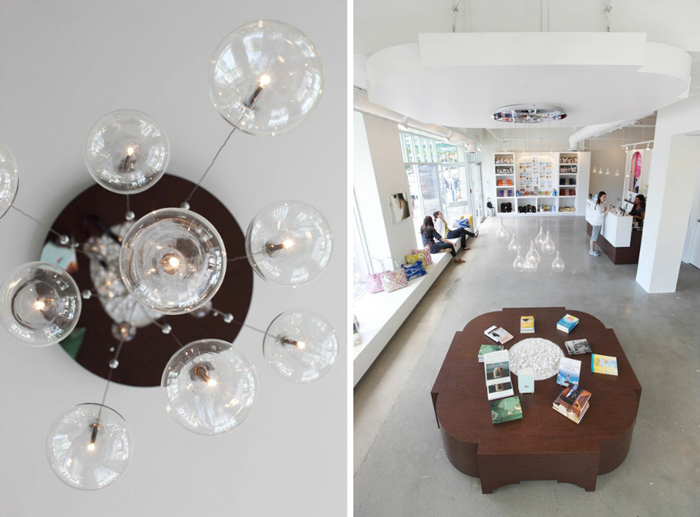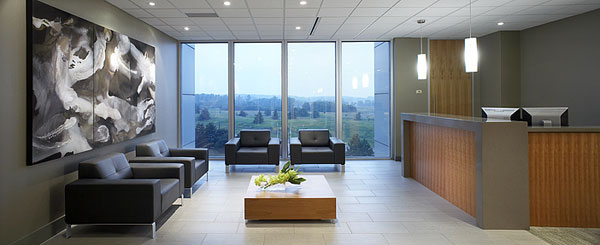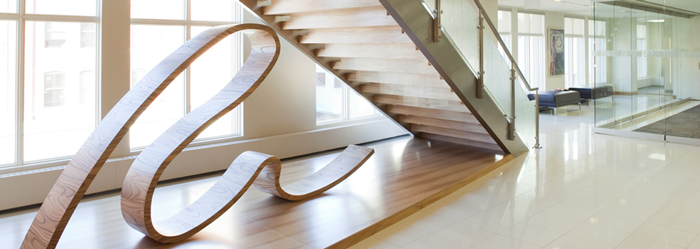If you are moving your business into a new space or renovating your existing space you will most likely be looking for professional Interior Design help. There are many Designers out there so, how do you know who to choose? We’ll arm you with the information you need to make an informed decision by explaining:
- Why all Designers are not created equal,
- How a qualified Designer can benefit you, and
- The steps for finding a qualified Designer.
Registered Interior Designer, Interior Designer, and Decorator: The Difference
First of all, it is important to understand how the title Registered Interior Designer (RID) differs from the titles Interior Designer or Decorator. Each definitely have their place in providing design services for your interiors, but for commercial projects (that typically require advanced technical knowledge and experience) hiring an RID ensures you will receive the highest levels of quality assurance.
 |
Semperviva Yoga Designed by Inoui Design Collective, RID’s in Victoria, BC. Photos by Makito Inomata
In British Columbia, and most provinces except for Ontario and Nova Scotia, the title âInterior Designerâ is not regulated. This means that currently anyone can call themselves an Interior Designer whether they are qualified or not. To ensure you are working with a qualified professional, make sure you look for a Registered Interior Designer/RID. Information on where you can go to find an RID, is provided a little later in this article.
The Road to Becoming an RID
The road to becoming a Registered Interior Designer (RID) involves many steps that ensure one has the education, experience, and skills necessary that allow them to write the North American examination. The National Council for Interior Design Qualification (NCIDQ) is a North American certification association who determines if a potential candidate meets the regulations to write the exam. While the education component has become ever stricter, it is guaranteed that an RID has a combination of education and qualified interior design work experience. Once the education and experience components of the application process have been verified it is time to write the exam. This is no easy task! If writing the entire three parts at once, you are writing three exams over two days, eight hours each day, very intense to say the least.
 |
Designed by KBH Interior Design Inc. in Toronto, Ontario.
Once you have successfully passed the three part NCIDQ exam you are ready to apply with your provincial association in order to practice professionally. But this is not all! Like most professions today, RIDâs are required to keep their knowledge up to date by completing a specified amount of continuing education to keep them current and informed.
How can an RID Benefit You?
So, if we still have your attention, we’re sure you’re wondering, how can working with a Registered Interior Designer (RID) benefit me? Well because RID’s have a reputable education, depth in experience, and a proven skill set – the highest level of recognition achievable for Interior Designers in BC and North America – they can create a space for your business that should:
- Enhance the quality of life for its occupants;
- Strengthen workplace productivity;
- Increase the frequency of consumer visits;
- Heighten consumer spending; and
- Augment business profitability.
An RID has experience on a variety of project types and their ability to solve problems allow them to create a comprehensive set of drawings – this attention to detail typically leads to fewer on-site changes thus keeping projects on budget and on schedule.
 |
Designed by Shearer Designs, in Calgary, Alberta.
Another benefit to you is that in order to maintain the title RID the Designer has to complete a required number of continued education courses each year. Because of this requisite, you can be sure your RID has the most up-to-date industry knowledge with which to apply on your project.
RIDâs are also required to carry Professional Liability Insurance and uphold a Professional Code of Ethics and Standards of Practice. Each of these requirements are of benefit to anyone hiring an RID.
If you would like more information regarding the benefits an RID can bring to your business, check out a variety of Whitepapers by clicking here.
How to Find a Registered Interior Designer
Now that you know about the profession and steps for Designers become qualified, how do you select a Registered Interior Designer (RID) that is right for your project?
Begin by doing some research:
The Interior Designers Institute of British Columbia (IDIBC) has a list on their website citing all RIDâs in British Columbia; this will enable you to find a Professional Interior Designer in your area. If you are located outside of British Columbia take a look on the website of the Interior Design Association serving your province for a similar listing of their members. The National Council for Interior Design Qualification (NCIDQ) also has a list of certificate holders available on their website. Although having the NCIDQ exam doesn’t make you an RID, it does mean you have met the minimum level for qualification as an Interior Designer in North America.
For a list of Provinces with regulated Interior Design Associations, see the Interior Designers of Canada website.
Check out candidate’s websites to determine what kind of projects the person or firm specializes in. Take a peek at their portfolio and look for references or testimonials.
 |
Design by Sizeland Evans in Calgary, AB.
Meet with or speak to the potential Designers:
It is important that you can connect and effectively communicate with the Interior Designer you select as communication is essential to the success of your project.
When interviewing your potential Interior Designer(s) there are a number of items that the Designer will want to address to ensure they can put a well-informed proposal together. Do some thinking about the following topics prior to the meeting to help facilitate the process:
- Your company’s brand, products and services, and how that relates to your preferred aesthetic style.
- Your timeline and completion date. Keep in mind the more time you are able to give your Designer and Contractor the better. When putting together a proposal, your Designer will consider the timeline – brisk timelines usually result in higher rates.
- Your budget. Be honest and forthcoming about the money you have to spend; a trustworthy designer (which an RID must be as they follow an enforced code of ethics) will work diligently to ensure they are designing within that amount or will tell you if the budget is impractical prior to accepting the project.
- Your existing furniture, fixtures or equipment that you wish to incorporate into the new workplace.
- Your plans for the growth of your business.
- Your values pertaining to green design or sustainability
- Information on any other consultants considered for the project - Engineers (Mechanical/Electrical/Structural), Architects, Lighting Designers, Acoustic Designers, General Contractors.
If most of these items are not addressed by the Interior Designer it might indicate that they are not a correct fit for your project. It’s also a good idea to ask the Interior Designer for references from past clients and other industry professionals.
 |
Designed by Design 360 Inc. in Halifax, NS.
Obtain proposal(s):
Request proposals from one or more of the Designers you are interested in working with. Preparing a detailed Scope of Work document beforehand will give the Designer(s) a basis from which to prepare their proposal. More information on preparing a Scope of Work document or Request for Proposal (RFP) will be discussed in an upcoming entry. Review and compare submitted proposals to ensure that the contender(s) has a good understanding of the scope of work involved and that all of the services you require are accounted for. The proposal should outline the terms of the agreement between the Client and Designer.
Award the project:
Make a selection based on the information you have gathered. Consider your timeline, budget, comfort level, and the Designer’s qualifications when making your decision. Make sure there is a written agreement or contract in place – typically this will be provided by the Designer and may be included in the proposal.
While the process may take anywhere from a week to a month, following these steps will have you working with a designer who you are comfortable with and more importantly, confident in. With the right designer the process should be fun and hassle-free, as they will take care to ensure that it is as smooth for you as it can be. Remember a Registered Interior Designer must look out for your best interest.
Good luck with your project!
» Interested in hiring our Registered Interior Designers for your next commercial project? Contact Hatch Interior Design located in Kelowna, British Columbia â Sustainable Interior Design Solutions for the Modern Workplace.
